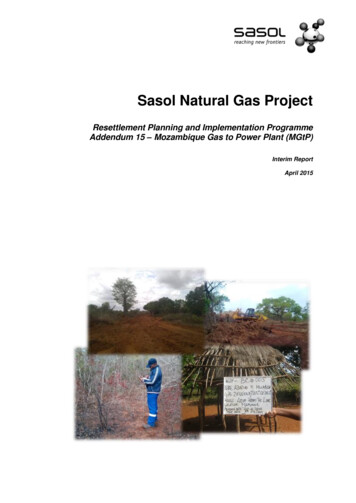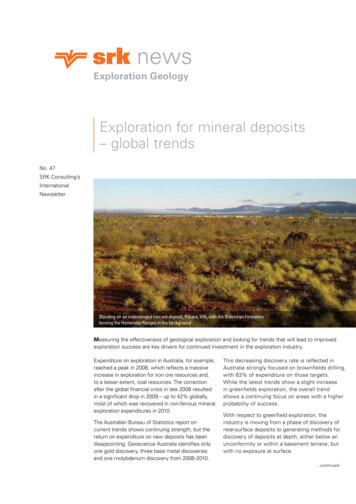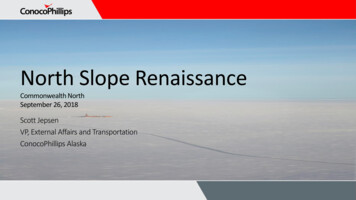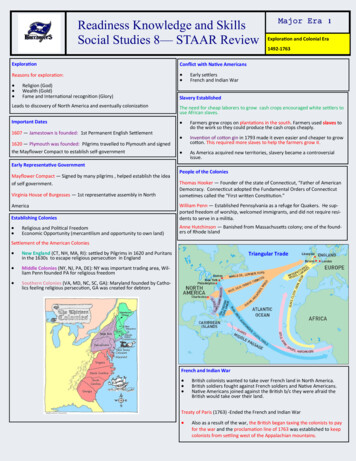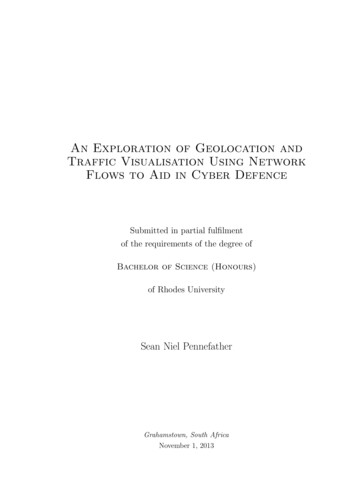
Transcription
An Exploration of Geolocation andTraffic Visualisation Using NetworkFlows to Aid in Cyber DefenceSubmitted in partial fulfilmentof the requirements of the degree ofBachelor of Science (Honours)of Rhodes UniversitySean Niel PennefatherGrahamstown, South AfricaNovember 1, 2013
AbstractA network flow is a record that represents the characteristics associated with a unidirectional stream of packets between two hosts using an IP layer protocol. As a network flowonly represents statistics relating to the data transferred in the stream, the effectiveness ofutilising network flows for traffic visualisation to aid in cyber defence is not immediatelyapparent and needs further exploration. The goal of this research is to explore the use ofnetwork flows for data visualisation and geolocation.A prototype system capable of collecting network flows exported using the NetFlow version9 protocol designed and was implemented as part of this research to aid in this exploration.This system processes the collected flow records and renders the geolocated results on aninteractive map in a web browser.Using conformance testing it is shown that the prototype system is capable of collectingnetwork flows and generating geolocated flow events in 50 milliseconds on the test platform. The system also provides functionality for the generation of heatmaps and tools forreplaying flow events from the client browser for further visual analysis. A reporter toolhas also been developed to produce monthly reports on the collected network flows.
AcknowledgementsAs the writer of this research paper, I would like to acknowledge the support receivedduring this research. I would first like to give thanks to my supervisor Professor BarryIrwin as his guidance and support has been essential to the success of this research.I am deeply indebted to my family for their continued love and support throughout thecourse of this year, their care and aid has allowed me to focus on the completion of thisthesis.I would also like to extend thanks to Mr John Richter for his guidance and support duringthis research.I would like to thank the NRF and Rhodes University for the financial support thatallowed me to complete this research. Finally I would like to acknowledge the financialand technical support of Telkom, Tellabs, Stortech, Genband, Easttel, Bright Ideas 39and THRIP through the Telkom Centre of Excellence in the Department of ComputerScience at Rhodes University.This research makes use of GeoLite data created by MaxMind.
Contents1 Introduction1.1 Problem Statement .1.2 Research Goals . . .1.3 Research Scope . . .1.4 Research Approach .1.5 Document Structure.2 Literature Review2.1 Introduction . . . . . . . . . . .2.2 What is a Flow . . . . . . . . .2.3 NetFlow . . . . . . . . . . . . .2.3.1 NetFlow Version 5 . . .2.3.2 NetFlow Version 9 . . .2.3.3 NetFlow Export timings2.4 IPFIX . . . . . . . . . . . . . .2.4.1 Transmission Protocols .2.4.2 Extended Characteristics2.4.3 Security Requirements .2.4.4 Packet Structure . . . .2.5 Network Flow Collectors . . . .2.5.1 Flowd . . . . . . . . . .2.5.2 Flow-tools . . . . . . . .2.5.3 nProbe . . . . . . . . . .2.6 Geolocation . . . . . . . . . . .2.7 Visualisation . . . . . . . . . . .2.8 Port Scanning . . . . . . . . . .2.9 Worms . . . . . . . . . . . . . .2.10 Denial of Service . . . . . . . .i.111334.556789141415151616171717181819202122
CONTENTSii2.11 Summary . . . . . . . . . . . . . . . . . . . . . . . . . . . . . . . . . . . . 233 Design3.1 Introduction . . . . . . . . . . . . . . . . . .3.2 System Goals . . . . . . . . . . . . . . . . .3.2.1 Geolocation . . . . . . . . . . . . . .3.2.2 Visualisation . . . . . . . . . . . . .3.3 System Constraints . . . . . . . . . . . . . .3.4 System Overview . . . . . . . . . . . . . . .3.5 Hardware and Resource Considerations . . .3.5.1 Record Storage . . . . . . . . . . . .3.5.2 Bandwidth Considerations . . . . . .3.5.3 Memory Considerations of the Client3.6 Security Measures . . . . . . . . . . . . . . .3.6.1 Exporter-Collector Security . . . . .3.6.2 Collector-Server Security . . . . . . .3.6.3 Client-Server Security . . . . . . . .3.6.4 Database Security . . . . . . . . . . .3.7 Collector . . . . . . . . . . . . . . . . . . . .3.7.1 Collection Component . . . . . . . .3.7.2 Parser Component . . . . . . . . . .3.7.3 Transmission Component . . . . . . .3.8 Server . . . . . . . . . . . . . . . . . . . . .3.8.1 Processor Component . . . . . . . . .3.8.2 Webserver Component . . . . . . . .3.9 Client . . . . . . . . . . . . . . . . . . . . .3.9.1 Websocket Component . . . . . . . .3.9.2 Real-time Component . . . . . . . .3.9.3 Heatmap Component . . . . . . . . .3.9.4 Replay Component . . . . . . . . . .3.10 Report Generator . . . . . . . . . . . . . . .3.10.1 Report Structure . . . . . . . . . . .3.10.2 Characteristic summary . . . . . . .3.10.3 IP graph . . . . . . . . . . . . . . . .3.10.4 Pie Charts . . . . . . . . . . . . . . .3.10.5 Line Graphs . . . . . . . . . . . . . .3.11 Summary . . . . . . . . . . . . . . . . . . 344444445454546464747
CONTENTS4 Implementation4.1 Introduction . . . . . . . . . . . . . . . . . .4.2 Programming Language Section . . . . . . .4.2.1 Compiled Languages . . . . . . . . .4.2.2 Interpreted Languages . . . . . . . .4.2.3 Supporting Python as a Language . .4.2.4 Supporting Javascript as a language .4.2.5 Pickle and Object serialisation . . . .4.2.6 Tornado Web Server . . . . . . . . .4.2.7 ReportLab . . . . . . . . . . . . . . .4.2.8 pyGeoIP . . . . . . . . . . . . . . . .4.2.9 Threading . . . . . . . . . . . . . . .4.3 Collector Implementation . . . . . . . . . . .4.3.1 Network Protocols . . . . . . . . . .4.3.2 Collector Thread . . . . . . . . . . .4.3.3 Sender Thread . . . . . . . . . . . .4.4 NetFlow Packet Parsing . . . . . . . . . . .4.4.1 Parser Thread . . . . . . . . . . . . .4.4.2 Parse Thread . . . . . . . . . . . . .4.5 Server Implementation . . . . . . . . . . . .4.5.1 Processor Component . . . . . . . . .4.5.2 WebServer Component . . . . . . . .4.6 Web Client Implementation . . . . . . . . .4.6.1 Interface Structure . . . . . . . . . .4.6.2 Initialisation . . . . . . . . . . . . . .4.6.3 WebSocket Communication . . . . .4.6.4 Map Initialisation . . . . . . . . . . .4.6.5 Live Communication . . . . . . . . .4.6.6 Heatmap Generation . . . . . . . . .4.6.7 Historical Replay . . . . . . . . . . .4.7 Reporter Implementation . . . . . . . . . . .4.7.1 Chart Colours . . . . . . . . . . . . .4.7.2 Report Structure . . . . . . . . . . .4.8 Summary . . . . . . . . . . . . . . . . . . 162626263646566676768715 System Evaluation725.1 Introduction . . . . . . . . . . . . . . . . . . . . . . . . . . . . . . . . . . . 72
CONTENTS5.25.35.45.5Geolocation conformance testing .5.2.1 Tools Used . . . . . . . . .5.2.2 Method . . . . . . . . . .5.2.3 Results . . . . . . . . . . .System Performance Testing . . .5.3.1 Timing and Accuracy . . .5.3.2 Bandwidth . . . . . . . . .System Demonstration . . . . . .Summary . . . . . . . . . . . . .iv.6 Conclusion6.1 Introduction . . . . . . . . . . . . . . .6.2 Summary of Chapters . . . . . . . . .6.3 Concluding results . . . . . . . . . . .6.3.1 Prototype System . . . . . . . .6.3.2 Real-time Geolocation . . . . .6.4 Research Review . . . . . . . . . . . .6.5 Closing Statement . . . . . . . . . . .6.6 Future Work . . . . . . . . . . . . . . .6.7 Development of a Suitable Flow Export. . . . . . . . . . . . . . . . . . . . . . . . . . . . . . . . .System.727374778181848688.90909091929293949495A Exportable Characteristics102B Sample system report105C Sample Heatmaps107
List of Figures2.12.22.32.42.52.62.72.8Standard NetFlow packet header . . . . . . . . . . . . . . .NetFlow Version 5 packet header (Cisco, 2006) . . . . . . . .NetFlow Version 5 packet record (Systems, 2004) . . . . . .NetFlow version 9 Packet Format (Cisco, 2011a) . . . . . . .NetFlow version 9 Packet Header (Cisco, 2011a) . . . . . . .NetFlow version 9 FlowSet Template Format (Cisco, 2011a)NetFlow version 9 Options Template Format (Cisco, 2011a)IPFIX Packet Header Format (Trammell et al., 2009) . . . ystem Overview . . . . . . .Collector Design . . . . . . . .Collection Component . . . .Parse Component . . . . . . .Processing a Template RecordProcessing a Data Record . .Server Component . . . . . .Server Processor . . . . . . . .Client Component . . . . . .Websocket Component . . . .Reporter Overview . . . . . tor implementation . . . . . . . . . . . . . . . .Server implementation . . . . . . . . . . . . . . . . .Overview of the event handling by the WebServer . .Example of a generated interactive map . . . . . . . .Example of a generated list of statistics and IP chartExample of generated pie charts . . . . . . . . . . . .Example of a generated line graph . . . . . . . . . .53575964686970.v.
LIST OF FIGURESvi5.15.25.35.45.55.65.7Geolocation information returned by the GeoIP2 Precision DemoGeolocation using Google Maps for coordinates from 5.1 . . . . .Images rendered by system for geolocation . . . . . . . . . . . . .Physical[B] and Geolocated[A] location of IP 146.231.123.92. . . .Generated heatmap for flows seen . . . . . . . . . . . . . . . . . .Generated heatmap for data transferred . . . . . . . . . . . . . .Flow event replay of download . . . . . . . . . . . . . . . . . . . atmap.107108108108ofofofoftotal bytes transferred . .flows recorded . . . . . . .unique hosts connected topackets transferred . . . .
List of Tables2.12.22.3Seven Characteristics of a Network Flow . . . . . . . . . . . . . . . . . . . 6Example NetFlow compatable routing devices (Cisco, 2012c) . . . . . . . . 7Common characteristics exported . . . . . . . . . . . . . . . . . . . . . . . 133.1Required record characteristics . . . . . . . . . . . . . . . . . . . . . . . . . 274.14.2List of implemented request tagsPossible heatmap e of IP addresses used in conformance testing . . . . .Database Records Extracted . . . . . . . . . . . . . . . . .Sample recorded results of time taken to process a networkRecorded results of time taken to parse received packets .Recorded results of time taken to serialise records . . . . .Times recorded for geolocation lookup and record storage .Recorded statistics of realtime traffic . . . . . . . . . . . .Recorded statistics of heatmap traffic . . . . . . . . . . . .Recorded statistics of replay traffic . . . . . . . . . . . . .System processing time . . . . . . . . . . . . . . . . . . . . . . . . . . . . . . . . . . . . . . . . . . 60. . . . . . . . . . . . . . . . . . . . . . . 65vii. . . . .flow. . . . . . . . . . . . . . .75808282838485858688
Chapter 1Introduction1.1Problem StatementNetwork flow processing has the potential to allow for a large reduction in the volumeof data to be processed by monitoring systems when compared to traditional packet processing counterparts. The reason for this reduction in volume is that a network flow is asingle record that represents the characteristics associated with an instance of communication between two hosts using an IP layer protocol (Morken, 2010). A flow record doesnot record the actual data transferred and as a result, the record size is only dependenton the number of characteristics the record must report on rather than the number ofpackets transferred for the duration of the connection.This allows network flows to be used to reduce the volume of data that must be processed.This reduction comes at the cost of not recording the actual content of the packets thatmake up the connection which are required by systems that employ packet analysis techniques as part of processing (Proctor, 2001). Because of this reduction in resolution, theeffectiveness of utilising network flows for traffic visualisation to aid in cyber defence isnot immediately apparent and needs further exploration.1.2Research GoalsAs companies expand, supporting networks must evolve to accommodate the resultingtraffic requirements. These requirements include support for increased traffic volume andtransmission speeds between internal and external networks. This increased volume still1
1.2. RESEARCH GOALS2needs to be monitored for both the health of the internal network and its connectionto external parties. Though this can continue to be done using purely packet basedprocessing and logging, the amount of memory and processing required increases. Theincreasing demand for more system resources result in companies needing to purchasemore hardware to maintain the current traffic monitoring system.The aim of this research is not to discount the credibility of continuing to use packetbased processing for traffic visualisation and network security but rather to explore thepotential of using network flows to achieve a similar goal. The exploration will cover twoareas of research: An exploration into the use of network flows for traffic visualisation to aid in ad-ministration and network security. The use of network flows for real-time geolocation and coordinate rendering.Due to the nature of how network flows are constructed, the default behaviour of theresponsible hardware is to report on the flows only after the communication is completewhich is discussed in section 2.3.3. This can be overridden so that the reporting devicereports on active flows in set intervals rather than waiting for them to complete. As thistime can be set, the timing tests will not record the duration from the initialisation of aflow to that flow being exported to the system.Though geolocation and coordinate rendering falls under data visualisation, it is significantenough to warrant mentioning as host addresses can be exported as a characteristic of aflow. A geolocation database can then be used to convert a host address into geographiccoordinates.In order to explore the feasibility of Network Flows in the above applications, it is necessary to develop a system that is capable of performing both geolocation and othertechniques for visually representing stored network flow records. This system must be capable of reading in raw Network Flow packets as they are received from the exporter andhandling flow record aggregation as well as representing both the record characteristicsand geolocation results visually to the system user.
1.3. RESEARCH SCOPE1.33Research ScopeDefining the research scope is important to formally describe the problems that are investigated in this research. The investigation will use the IPv4 address space and not theIPv6 address space. The results produced in this research with regards to flow geolocation and data visualisation wilzl be the same for both IPv4 and IPv4. However, to limitcomplexity and due to the lack of quality IPv6 golocation databases, IPv6 will not besupported.The system implemented to perform this research is not capable of sending or receivingNetFlow options templates or NetFlow options records. NetFlow options templates andNetFlow options records form part of the NetFlow version 9 protocol and are discussedfurther in chapter 2. The reason for this is that adding the additional functionality to thesystem does not effect the research performed. NetFlow options records are used to sendinformation regarding the actual process used to generate the network flows which is notrequired to achieve the goals described in section 1.2 (Cisco, 2011a).The research will be host based rather than network based. Network based geolocation anddata visualisation require maintenance of multiple source IP addresses and the producedresults will need to be generated for each source address. Furthermore, flow exportingsystem used in this research is Softflowd1 which is host based and exports flows only forthe source IP address on the platform on which it is running.The results of data visualisation will focus on identifying the type of visualisation that canbe performed using network flows. As data visualisation is largely dependent on specificrequirements of the user, the results produced for this research are a proof of concept.For determining the applicability of a realtime system utilising network flows, timing concerns will focus on network flow generation and flow processing by an implemented system.Timings regarding communication between the Server and Client will be considered outof scope due to its reliance on the connecting network path.1.4Research ApproachThe approach taken to achieve the goals outlined in section 1.2 is to design a prototypesystem capable of flow geolocation and data visualisation. The designed system is then1Softflowd is a software based flow export system (Miller, 2011)
1.5. DOCUMENT STRUCTURE4implemented and tested to insure suitable functionality.1.5Document Structure An in depth investigation of network flows is covered in chapter 2 which includes adiscussion regarding the protocols used to export raw flows from the flow exportingsystem. Geolocation and data visualisation is discussed along with network treatsand common intrusion techniques. An investigation into network flow exportingsystems completes the chapter. A prototype system is proposed and designed in chapter 3. This chapter identi-fies goals the proposed system must achieve and the design is partitioned into thecomponents necessary to achieve them. Chapter 4 focuses on the system implementation. This chapter notes techniquesused to implement the functionality described in chapter 3 as well as identify andpromote the selected language for implementation. Conformance tests are designed and carried out in chapter 5 to test if the imple-mented system is capable of successfully performing flow geolocation. Synthesiseddata is used to time the system components when completing necessary tasks. Thedata is also in generating statics of the generated system traffic. The tests arefollowed by an evaluation of other data visualisation aspects of the system. Findings of this research are concluded in chapter 6 and is followed by a discussionof future research.
Chapter 2Literature Review2.1IntroductionThis chapter provides the necessary background information regarding industry leadingprotocols for exporting raw flow data. These protocols are used by high level switching orrouting devices to export raw flow data to target systems within a closed network. Theterm ‘network flow’ is discussed in terms of the definition provided by Cisco which is aunidirectional sequence of packets that all have seven characteristics in common (Cisco,2012c). These seven characteristics are listed in table 2.1 and are used to define the activeflow that a packet belongs to.Three network flow protocols are discussed in this chapter. As protocols NetFlow version5 (Cisco, 2006) and NetFlow version 9 (Claise & Systems, 2006) are both provided byCisco, they are compared first in section 2.2. The comparison is done to highlight thedifferences between the two versions which includes the advantages and disadvantagesof using each. Following the Cisco protocols, literature relating to IP Flow InformationeXport (IPFIX) (Claise et al., 2013) is reviewed in section 2.4. The review of each protocolincludes a discussion about packet structure and implementation.This chapter includes a discussion on port scanning in section 2.8 which highlights commontechniques used to scan the network ports of an addressable host. This followed by aninvestigation into worms and denial of service (DoS) attacks. Different systems thatare capable of collecting network flows are investigated in section 2.5. The investigationincludes a brief overview of each system and how it is used to process collected flows.Finally, a brief overview of geolocation is discussed in section 2.6 and is followed by a5
2.2. WHAT IS A FLOW6Table 2.1: Seven Characteristics of a Network FlowSource IP AddressDestination IP AddressSource PortDestination PortProtocolToS ByteInterfacediscussion of data visualisation. This chapter concludes in section 2.11 with a summaryof the material covered.2.2What is a FlowThe concept of a Network Flow was patented by Kerr and Bruins on 28 May 1996. Theconcept was created as an efficient means to report on network status and traffic patternsas seen by routing devices for a related sequence of packets. Initially, a flow was defined asa set of packets all destined for the same destination IP address and all originating fromthe same source address. Further identification of a unique flow included the requirementthat all packets have the same destination port. (Kerr & Bruins, 1996)According to Cisco (Cisco, 2012c), a flow is defined as a unidirectional sequence of packetsbetween two end hosts over a network. Each packet in the sequence must display the same7 characteristics shown in figure 2.1 to be considered part of a single network flow. Thedirection of the flow is determined by the host that began the communication.This flow data which is generated by routing or switching devices such as those made byCisco (Cisco, 2012a) and Juniper (Juniper Networks, 2013). The generated data can thenbe transferred to other devices for analysis to help identify potential network faults andmonitor resource use, typically for billing purposes. This data can further be analysedto only display information pertaining to a particular network mask, a particular date ortime, and overall resource use.The construction of the raw flow data is traditionally done at hardware level in compatiblerouting or switching devices. Examples of compatible routers include those shown in table2.2 which are supplied by Cisco and JunOS routers supplied by Juniper (Scheck & CSIRT,2009). As it is already necessary for such devices to analyse received packets for routing
2.3. NETFLOW7Table 2.2: Example NetFlow compatable routing devices (Cisco, 2012c)Platform NameCisco 12000Cisco 800Catalyst 65k/7600NetFlow Export Version(s)v5 v8 v9v9v5 v8 v70 1 2 3 4 5 6 7 8 9 10 11 12 13 14 15 16 17 18 19 20 21 22 23 24 25 26 27 28 29 30 31VersionCountSystem UptimeUNIX SecondsFigure 2.1: Standard NetFlow packet headerpurposes, a hardware level approach allows the device to generate the flows using theunpacked packets. Characteristics recorded include the basic components shown in table2.1 as well as any additional information that the router is configured to collect such aspacket length and count.In order to then transfer the recorded data collected on observed flows to another devicefor processing, a raw flow exporting protocol is employed. The exporting can occur whenthe generating system concludes that a flow has expired or in set intervals regardless.Currently, the significant raw flow export protocols are those developed by Cisco calledNetFlow version 5 and NetFlow version 9 (Cisco, 2011a). Additionally, a new protocolis currently under development by the Internet Engineering Task Force (IETF) calledIPFIX (Claise et al., 2013). Though still in development, implementations of the protocolare currently in use by network components such as the Barracuda NG Firewall1 .2.3NetFlowAll versions of the NetFlow protocol currently available use the same packet header formatfor representing version, count and timings. This helps developers to produce collectorsoftware capable of handling different NetFlow protocols. Figure 2.1 shows the format ofthe first 96 bits of a packet header. The count field indicates the number of flows thatare contained within the packet with the exception of NetFlow version 9 where this fieldindicates the number of flow sets contained (Cisco, 2011a). The concept of a flow set is1Only versions 5.2.3 and above are IPFIX compatible (Barracuda, 2013)
2.3. NETFLOW80 1 2 3 4 5 6 7 8 9 10 11 12 13 14 15 16 17 18 19 20 21 22 23 24 25 26 27 28 29 30 31VersionCountSystem UptimeUNIX SecondsUNIX NanosecondsFlow SequenceTypeIDSampling Interval (24 bits)Figure 2.2: NetFlow Version 5 packet header (Cisco, 2006)explained in more detail in section 2.3.2.2.3.1NetFlow Version 5NetFlow version 5 is currently the most widely used protocol that is developed by Ciscofor exporting raw flows from routing devices to the collector (Lee et al., 2010).Figure 2.2 shows the full NetFlow version 5 packet header which consists of 9 fields and is24 bytes long. The first 12 bytes of the header that are common to all NetFlow protocolsversions and shown above in figure 2.1. This is followed by the residual nanoseconds sincethe first day UNIX which is defined in RFC 5905 to begin on 1 January 1970 (Mills et al.,2010). The flow sequence number is a running count of the number of flows seen by theexport device. The Type and ID fields in figure 2.1 are used to associate the packetsexported with a specific export device on the network. The final 3 bytes in the sequenceare reserved for the sampling interval where the first 2 bits determine the sampling modeand the remaining 14 bits hold the value.The Input and Output fields in figure 2.3 are the Simple Network Management Protocol(SNMP) index numbers. The SNMP protocol is responsible for communicating management variables between the managing devices and host as defined in RFC 1157 (Caseet al., 1990).Both the First and Last fields in figure 2.3 hold a time value in millisecondssince the recording device was booted. The values are timestamps of the first and lastpackets routed in the flow.Next are the fields Source As and Destination As are Autonomous System Numbers (ASN)which are used to identify the Autonomous System that each end host resides in. TheAutonomous System (AS) is described in RFC 4271 (Rekhter et al., 2006) as a collectionof routers that use an Interior Gateway Protocol along with set metric rules to determinehow to route packets. Though the routers may internally use a variety of metrics to
2.3. NETFLOW90 1 2 3 4 5 6 7 8 9 10 11 12 13 14 15 16 17 18 19 20 21 22 23 24 25 26 27 28 29 30 31Source AddressDestination AddressNext HopInputOutputPackets RecordedOctetsFirstLastSource PortPadTCP ProtoDestination AsDestination PortToSSource AsS Msk D MskPadFigure 2.3: NetFlow Version 5 packet record (Systems, 2004)determine the routing paths between different internal components, the AS is seen to usea single routing algorithm externally.Two disadvantages of using NetFlow version 5 over its successor variants are that it doesnot support IPv6 and the structure of exported packets is static (Systems, 2004). IPv6has become increasingly prevalent as services such those provided by Google are nowaccessible using IPv6 addressing2 . Flow records exported under the NetFlow version 5protocol are limited to only exporting data in the defined fields of the record and cannotchange during system runtime. Both of these issues are addressed in NetFlow version 9.2.3.2NetFlow Version 9NetFlow version 9 is a raw flow export protocol that dynamically structures the contentsof the exported flow data records according to a previously exported template (Cisco,2011a). This allows collecting systems to process NetFlow version 9 data packets
As a network ow only represents statistics relating to the data transferred in the stream, the e ectiveness of utilising network ows for tra c visualisation to aid in cyber defence is not immediately apparent and needs further exploration. The goal of this research is to explore the use of network ows for data visualisation and geolocation.
